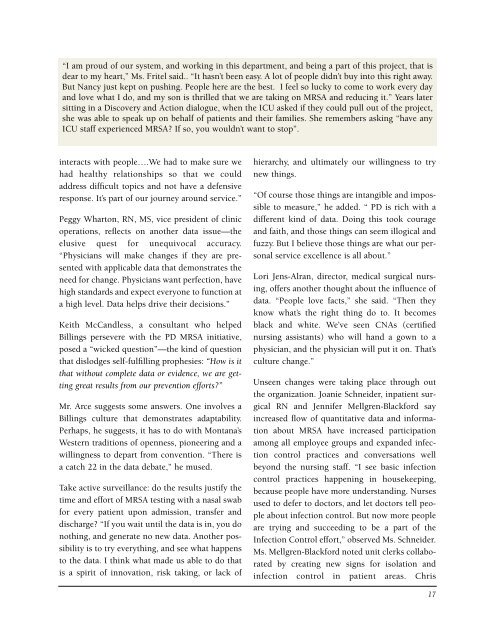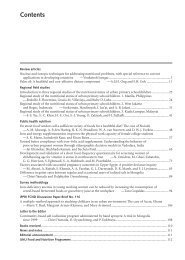From Invisible to Visible - Positive Deviance Initiative
From Invisible to Visible - Positive Deviance Initiative
From Invisible to Visible - Positive Deviance Initiative
Create successful ePaper yourself
Turn your PDF publications into a flip-book with our unique Google optimized e-Paper software.
“I am proud of our system, and working in this department, and being a part of this project, that is<br />
dear <strong>to</strong> my heart,” Ms. Fritel said.. “It hasn’t been easy. A lot of people didn’t buy in<strong>to</strong> this right away.<br />
But Nancy just kept on pushing. People here are the best. I feel so lucky <strong>to</strong> come <strong>to</strong> work every day<br />
and love what I do, and my son is thrilled that we are taking on MRSA and reducing it.” Years later<br />
sitting in a Discovery and Action dialogue, when the ICU asked if they could pull out of the project,<br />
she was able <strong>to</strong> speak up on behalf of patients and their families. She remembers asking “have any<br />
ICU staff experienced MRSA? If so, you wouldn’t want <strong>to</strong> s<strong>to</strong>p”.<br />
interacts with people….We had <strong>to</strong> make sure we<br />
had healthy relationships so that we could<br />
address difficult <strong>to</strong>pics and not have a defensive<br />
response. It’s part of our journey around service.”<br />
Peggy Whar<strong>to</strong>n, RN, MS, vice president of clinic<br />
operations, reflects on another data issue—the<br />
elusive quest for unequivocal accuracy.<br />
“Physicians will make changes if they are presented<br />
with applicable data that demonstrates the<br />
need for change. Physicians want perfection, have<br />
high standards and expect everyone <strong>to</strong> function at<br />
a high level. Data helps drive their decisions.”<br />
Keith McCandless, a consultant who helped<br />
Billings persevere with the PD MRSA initiative,<br />
posed a “wicked question”—the kind of question<br />
that dislodges self-fulfilling prophesies: “How is it<br />
that without complete data or evidence, we are getting<br />
great results from our prevention efforts?”<br />
Mr. Arce suggests some answers. One involves a<br />
Billings culture that demonstrates adaptability.<br />
Perhaps, he suggests, it has <strong>to</strong> do with Montana’s<br />
Western traditions of openness, pioneering and a<br />
willingness <strong>to</strong> depart from convention. “There is<br />
a catch 22 in the data debate,” he mused.<br />
Take active surveillance: do the results justify the<br />
time and effort of MRSA testing with a nasal swab<br />
for every patient upon admission, transfer and<br />
discharge? “If you wait until the data is in, you do<br />
nothing, and generate no new data. Another possibility<br />
is <strong>to</strong> try everything, and see what happens<br />
<strong>to</strong> the data. I think what made us able <strong>to</strong> do that<br />
is a spirit of innovation, risk taking, or lack of<br />
hierarchy, and ultimately our willingness <strong>to</strong> try<br />
new things.<br />
“Of course those things are intangible and impossible<br />
<strong>to</strong> measure,” he added. “ PD is rich with a<br />
different kind of data. Doing this <strong>to</strong>ok courage<br />
and faith, and those things can seem illogical and<br />
fuzzy. But I believe those things are what our personal<br />
service excellence is all about.”<br />
Lori Jens-Alran, direc<strong>to</strong>r, medical surgical nursing,<br />
offers another thought about the influence of<br />
data. “People love facts,” she said. “Then they<br />
know what’s the right thing do <strong>to</strong>. It becomes<br />
black and white. We’ve seen CNAs (certified<br />
nursing assistants) who will hand a gown <strong>to</strong> a<br />
physician, and the physician will put it on. That’s<br />
culture change.”<br />
Unseen changes were taking place through out<br />
the organization. Joanie Schneider, inpatient surgical<br />
RN and Jennifer Mellgren-Blackford say<br />
increased flow of quantitative data and information<br />
about MRSA have increased participation<br />
among all employee groups and expanded infection<br />
control practices and conversations well<br />
beyond the nursing staff. “I see basic infection<br />
control practices happening in housekeeping,<br />
because people have more understanding. Nurses<br />
used <strong>to</strong> defer <strong>to</strong> doc<strong>to</strong>rs, and let doc<strong>to</strong>rs tell people<br />
about infection control. But now more people<br />
are trying and succeeding <strong>to</strong> be a part of the<br />
Infection Control effort,” observed Ms. Schneider.<br />
Ms. Mellgren-Blackford noted unit clerks collaborated<br />
by creating new signs for isolation and<br />
infection control in patient areas. Chris<br />
17

















